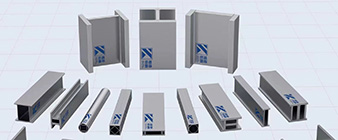Chemical composition:
UNS S32570 (2507) is a superduplex stainless steel with higher chromium (24-26%) and molybdenum (3-4%) content compared to 1.4410.
1.4410 is also a duplex stainless steel but contains slightly less chromium (24-26%) and molybdenum (2.5-3.5%).
Corrosion resistance:
UNS S32570 (2507) Due to its high chromium and molybdenum content, it has excellent corrosion resistance, especially in chloride-containing environments.
1.4410 also exhibits excellent corrosion resistance, but may be slightly less resistant to pitting and crevice corrosion than 2507.
Mechanical Properties:
UNS S32570 (2507) generally has higher tensile and yield strengths, typically in the range of 800-1000 MPa and 550-700 MPa respectively.
1.4410 also has high strength, but its typical tensile strength and yield strength are slightly lower than 2507, about 700-900 MPa and 500-650 MPa respectively.
Resilience and Fatigue:
2507 and 1.4410 exhibit excellent toughness and fatigue resistance due to their dual-phase microstructure.
However, 2507 may have a slight advantage in terms of fatigue life and resistance to crack growth.
Solderability and Fabrication:
Both 2507 and 1.4410 can be welded easily, but welding parameters require careful control of the welding parameters to maintain the required ferrite-austenite balance.
The higher strength of 2507 compared to 1.4410 may slightly increase the challenges associated with welding and fabrication.
Cost and Availability: 1.4410 is generally more widely available and may cost slightly less than the more specialized 2507 super duplex stainless steel.
Excellent corrosion resistance, especially in chloride-rich environments
Greater strength and structural integrity for more efficient, lighter designs
Improve long-term durability and reduce maintenance requirements
However, the selection of 2507 and 1.4410 stainless steel structural profiles in water treatment applications should also consider factors such as project requirements, cost and availability. In some cases, the slightly lower cost and wider availability of 1.4410 may make it a more suitable choice, depending on the specific application and environmental conditions.
-
 2024-9-20 1.4404 stainless steel profiles in construction engineering innovative applications
2024-9-20 1.4404 stainless steel profiles in construction engineering innovative applications -
 2024-9-19 1.4410 Stainless Steel Hollow Profiles Application in Water Treatment
2024-9-19 1.4410 Stainless Steel Hollow Profiles Application in Water Treatment -
 2024-9-25 318LN / 1.4462 Duplex Stainless Steel Structural Profiles
2024-9-25 318LN / 1.4462 Duplex Stainless Steel Structural Profiles -
 2023-12-12 Technical application of high-strength S690 steel profiles
2023-12-12 Technical application of high-strength S690 steel profiles -
 2024-9-15 Introduction to the performance of 1.4301/1.4307 stainless steel
2024-9-15 Introduction to the performance of 1.4301/1.4307 stainless steel -
 2024-9-16 Innovative applications of duplex and super duplex stainless steel structural sections:
2024-9-16 Innovative applications of duplex and super duplex stainless steel structural sections: -
 2024-9-25 1.4301 Stainless steel hollow structural profiles
2024-9-25 1.4301 Stainless steel hollow structural profiles



